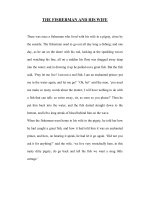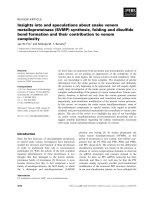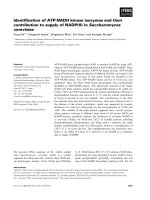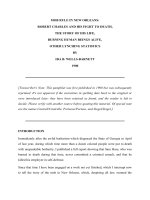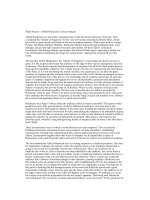alfred hitchcock and his contribution to hollywood
Bạn đang xem bản rút gọn của tài liệu. Xem và tải ngay bản đầy đủ của tài liệu tại đây (43.32 KB, 3 trang )
Throughout history there have been many directors who have made their impact on the world of
movies but few of them have had the same impact that Alfred Hitchcock has had. Hitchcock has
been seen as a very complex yet important figure in the history of film making. He has directed
some of the best suspense films known to man. He also had his own television show in the 50's
known as Alfred Hitchcock Presents.
Alfred Joseph Hitchcock was born in England in a little town outside of London on the thirteenth
of August in eighteen ninety-nine, to William and Emma Hitchcock. He had two older siblings,
William and Nellie. The family was a lower middle class family living in Leytonstone, England.
William Hitchcock was a dealer of fruit and poultry, and his business did quite well. According to
John Russell Taylor, in his tell-all biography, Hitch (1978); Hitchcock was a child who kept to
himself because of the fact that his older siblings were so much older than him (Taylor, 1978).
Hitchcock was educated at many different schools. His first school was a school which was
located directly behind his house, operated by the Faithful Companions of Jesus. Hitchcock did
not stay there long because, according to Taylor (1978), "Father Flanagan came and gave his
parents hell for sending him to a secular school" (29). Following the secular school was the
Selesian College in Battersea in which Hitchcock was sent to board at the tender age of nine.
Finally Hitchcock ended up at St. Ignatius College where he stayed until he was fourteen years
old. Hitchcock only left school after his father died in 1914. After he left school he decided to
enroll in the School of Engineering and Navigation because he was interested in becoming an
engineer. While at school he became interested in the arts and so he then decided to go to school
for the arts and he ended up at London University where he studied fine arts (Perry, 1965).
In George Perry's book, The Films of Alfred Hitchcock, from the years of 1921 to 1929,
Hitchcock worked on silent films, first as the title card designer and then as the director. But he
did not start out at the production studio he actually started out in this business at a small
advertising firm getting about fifteen shillings a week (Perry, 1965). According to George Perry
(1965), "From there he went to W.T. Henley, the cable company, as a layout man" (7). This firm
was very embracing of Hitchcock's artistic demeanor. Henley had a newspaper which their social
club published and Hitchcock regularly had drawings and stories in them (Taylor, 1975). During
this time Hitchcock was introduced to the idea of drawing title cards, which he took in stride. Very
soon after starting his title card drawing he was hired by the Famous Players-Lasky production
company. While working at this company he had his first directing experience which he was
talked into by Anita Ross, the publicity woman (Perry, 1965 and Taylor, 1978). The movie was
called Mrs. Peabody, but Hitchcock referred to it as Number Thirteen, probably because no one
had ever really decided on a name (Taylor, 1978). This film was never completed because of
money problems. The next chance Hitchcock was given was as a co-director of the film, Always
Tell Your Wife (Perry, 1965). Always Tell Your Wife was followed by Woman to Woman which
he was the assistant director.
Alfred Hitchcock's first talkie was not done until 1929 and it was called Blackmail. This movie
was also Britain's first talkie movie. Blackmail featured Anny Ondra, a German actress who can
be called the first of Hitchcock's blonde prototypes. Following Blackmail was Juno and the
Paycock which was a musical screenplay. This was not a thriller in any sense and Hitchcock's next
film went back to the thriller genre called, Enter Sir John (Perry, 1965). The movie Hitchcock
considers his first movie is The Lodger because it had such a big response when it came out. "Still
whether or not critics and audiences picked up on everything in the film, they pick up on enough
to make it and Hitch an overnight sensation" (Taylor, 1965).
All during this time Hitchcock had been working on his own family. He had married a woman
named Alma Reville, whom he met when filming Woman to Woman in 1922. Alma was the editor
on this film and she had a higher job than Hitchcock did and in those days a man could not
acknowledge the fact that a woman had a higher job than him so Alfred waited until he had a
higher position than her to speak to her. When they did speak they took a liking to each other and
then after a long engagement they were married. Their wedding was small and took place on
December 2, 1926. Alma and Alfred had a small wedding with immediate family and a couple
close friends. After the wedding they cut the cake in their new apartment and left for their
honeymoon in France. Their married life was just fine and then Alma became pregnant and on
July 7th, 1928 she gave birth to Patricia Hitchcock (Taylor, 1978).
In 1940, Alfred Hitchcock and his family came to Hollywood. When he arrived in Los Angeles,
he and his family moved into an apartment on Wilshire Boulevard. Almost immediately after
arriving in America Hitchcock threw himself into working on a new project, a movie titled
Rebecca. Rebecca turned out to be a very expensive and successful movie. Even though the movie
was a success Hitchcock still wondered whether it would have been even better had it been filmed
in England. In the years following Hitchcock directed many movies for instance Foreign
Correspondence, Mr. and Mrs. Smith, Strangers on a Train, Spellbound, Rope and many others.
In the 1950's Hitchcock was told he should be on air, meaning he should be on television.
Television was a new medium in that time and many of the Hollywood people looked down on it.
Hitchcock was thrilled by the idea of being on television and he jumped at the chance. With great
haste he set up a company called Shamley Productions. He then called up an old business partner
and asked her to produce the show, Joan Harrison agreed and they had a show. The show has the
same cynical dark humor that is often found with Alfred Hitchcock. The television show was a
success, "but the television shows were just the beginning of what was to turn into a whole
industry. They spawned a lengthy series of short story anthologies with titles like "Stories They
Wouldn't Let me Do on TV" and "Tales My Mother Never Told Me", collections of the kind of
funny/macabre story made familiar and permanently associated with Hitch's name as a result of the
television show" (231). This venture eventually made him independently wealthy.
In 1957, Hitchcock began making the movie Vertigo starring James Stewart, Kim Novak and
Barbara Bel Geddes. This movie showed many shots which were very innovative for the time. For
example in the beginning of the film when James Stewart's character John "Scottie" Ferguson, is
in the studio of his friend, Midge Wood, he is talking about his illness which is vertigo. He is
telling Midge how he thinks he is getting better and to prove it he steps up on a step stool and
climbs to the top of it. Then he looks out the window and sees how far above the ground he is and
he gets dizzy and begins to fall. When the camera shows the shot of what he sees out the window
it looks as if he is about 30 stories up, when in fact the was not close to being that high up, it was
all the camera angle. The scenes in this movie are also very well shot throughout the movie. It is a
well known fact that most of the backdrops in Hitchcock's movies where painted and most people
cannot even tell this because of the expert shots taken by the camera man.
After the television show Hitchcock returned to making movies. The one movie he is most known
for is Psycho staring Janet Leigh. Psycho had the biggest opening Hitchcock had ever seen in his
time as a director. Then after a brief two year hiatus out came The Birds, which turned out to be
another Hitchcock masterpiece. Hitchcock's last movie came out in 1976. The movie was called
Family Plot.
Most of Hitchcock's work was done in black and white which gave the work a certain feeling of
suspense. Also the fact that he did not show most of the violence in the movies also helped to add
the need for the audience to use their imaginations. When a movie is in black and white it is up to
the viewer to use their imagination about the colors. The shades of black, white and grey make the
whole aura of the film seem a lot more sinister and slightly leering. Even when films where being
made in color Hitchcock stayed with the black and white; if his movies had been done in color the
audience would not have had the same feeling of unease.
A lot of people found Alfred Hitchcock to be a very complex as well as eccentric man. One of the
things that stood out about him was the fact that he started the tradition of appearing in all of his
movies. He never had a very large role, but he would have one none the less. For instance he
would be a random person sitting on a train or he would just causally walk by on the street.
Finding him in his movies became a hobby held by many of his fans. Some other eccentric
features of him were the fact that he would fall asleep at random times like, at dinner parties or
when he was out with friends. It became an expected habit from him. Another strange fact about
him was found in the book, The Men Who Made the Movies, in which the author Robert Schickel
(1975) says that Hitchcock never drove a car because he did not have his license. Meanwhile in
the book Hitch, by John Russell Taylor (1978) it says that he was just pretending not to ever drive.
Taylor also says that Hitchcock used to drive Pat, his daughter to church every Sunday. The last
really strange fact about Hitchcock was his love for blondes. He had a certain type of blond in
mind at all times, for a while it was Tippi Hedren and then it became Janet Leigh. Hitchcock
became synonymous for his blondes.
I believe that Hitchcock had a very positive influence on society because without him I really do
not think we would have such a good sense of real suspense. Psycho had such a profound touch on
our lives. Many people who saw the film left the theater and were petrified of taking a shower.
There is no way a person can say that Alfred Hitchcock had a negative influence on the film
industry, all he did was help it. He helped to make television an okay medium even after
Hollywood shunned it. His use of black and white and his lack of gore made suspense movies
what they are today. Today many directors feel that they have to show the brutal murder of their
characters in order to scare their viewers, when in all actuality the brutal murder just shocks the
viewers. Hitchcock knew the secret was to let the audience imagine how horrific the murder would
have been, that what would really scare someone. If one were to try and imagine suspense movies
without Hitchcock, one would be horribly disappointed. Alfred Hitchcock is in my opinion the
master of all suspense and thriller movies.
Perry, G. (1965). The Films of Alfred Hitchcock. London: Studio Vista Limited.
Schickel, R. (1975). The Men who made the movies. New York: Atheneum.
Taylor, J.R. (1978). Hitch: The life and times of Alfred Hitchcock. New York: Pantheon Books.
Vertigo. Dir. Alfred Hitchcock. Per. James Stewart, Kim Novak, and Barbara Bel Geddes.
Universal, 1999.
